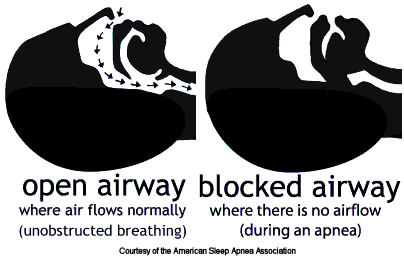
*Obstructive Sleep Apnea:*

I’m sure we all have an Uncle (fill in the blank) who was teased for his terrible snoring. Hopefully for many Americans that is a thing of the past. Sleep Medicine is a quickly growing specialty. Both Neurologists and Pulmonologists consider Obstructive Sleep Apnea their turf. What is Obstructive Sleep Apnea?
Obstructive Sleep Apnea (OSA) or Sleep Disorder Breathing is the absence or disruption of breathing during sleep. Sounds scary because when you think about it OSA is scary.
Obstructive Sleep Apnea can be caused by the collapsing of the soft palate, tongue, enlarged tonsils or uvula or any combination of these. The diagram below illustrates the blocked airway.

The airflow in the picture to the left is a normal airflow pattern. The picture to the right depicts the common disruption of airflow. In this picture what is not shown is the blocked or partially blocked airflow which results in snoring. Let’s take a moment and define some terms:
Apnea:
… the absence of breathing. In the study of Sleep Disorder Breathing, any blockage of air flow greater than 80% is considered apnea.
Hypopnea:
…slow, shallow breathing.
Obstructive Sleep Apnea:
…the disruption of healthy sleep patterns by mechanical obstruction of the normal airflow/breathing pattern.
Central Sleep Apnea:
…a disruption of the normal sleep breathing by a lack of stimulus from the brain.
OSA is sometimes confused with Central Sleep Apnea(CSA). The simple way to understand the difference of OSA and CSA is that OSA is a mechanical blockage decreasing or stopping airflow while CSA originates in the brain. Simply put, CSA is the brain failing to tell the body to breathe.
The effects of untreated OSA can be heart arrhythmias, stroke, heart attack. Men are 2-3 times more likely to suffer OSA than women. While obesity may be a common factor, 40% of OSA sufferers are not obese. How is OSA treated?
There are basically two common treatment options for OSA. One option is to undergo a surgery commonly referred to as the "U triple P". Uvulopalatopharneoplasty is a surgery that removes soft tissue thereby enlarging the oral airway. The success rate for this surgery hovers around 48%. The second option is significantly less invasive.
Continual Positive Airway pressure (CPAP) is the most common form of treatment of OSA. CPAP is the application of a constant airway pressure to hold the airway open while the patient sleeps and breathes normally.
A common analogy for CPAP therapy is when you stick your head out of a car window while the car is traveling at a high rate of speed. Air is forced into your mouth/airway. While strange feeling, this constant pressure does not cause you to choke, pass out or have any deleterious side effects save an occasional bug in the mouth.
Additional types of therapies include Bi-level (aka BiPAP) and NPPV.
In conclusion, if your loved one snores or has other unusual nighttime behaviors it is probably time to send in to see if they suffer from Obstructive Sleep Apnea.
aricrn
www.alpharubicon.com
All materials at this site not otherwise credited are Copyright © 1996 - 2007 Trip Williams. All rights reserved. May be reproduced for personal use only. Use of any material contained herein is subject to stated terms or written permission.